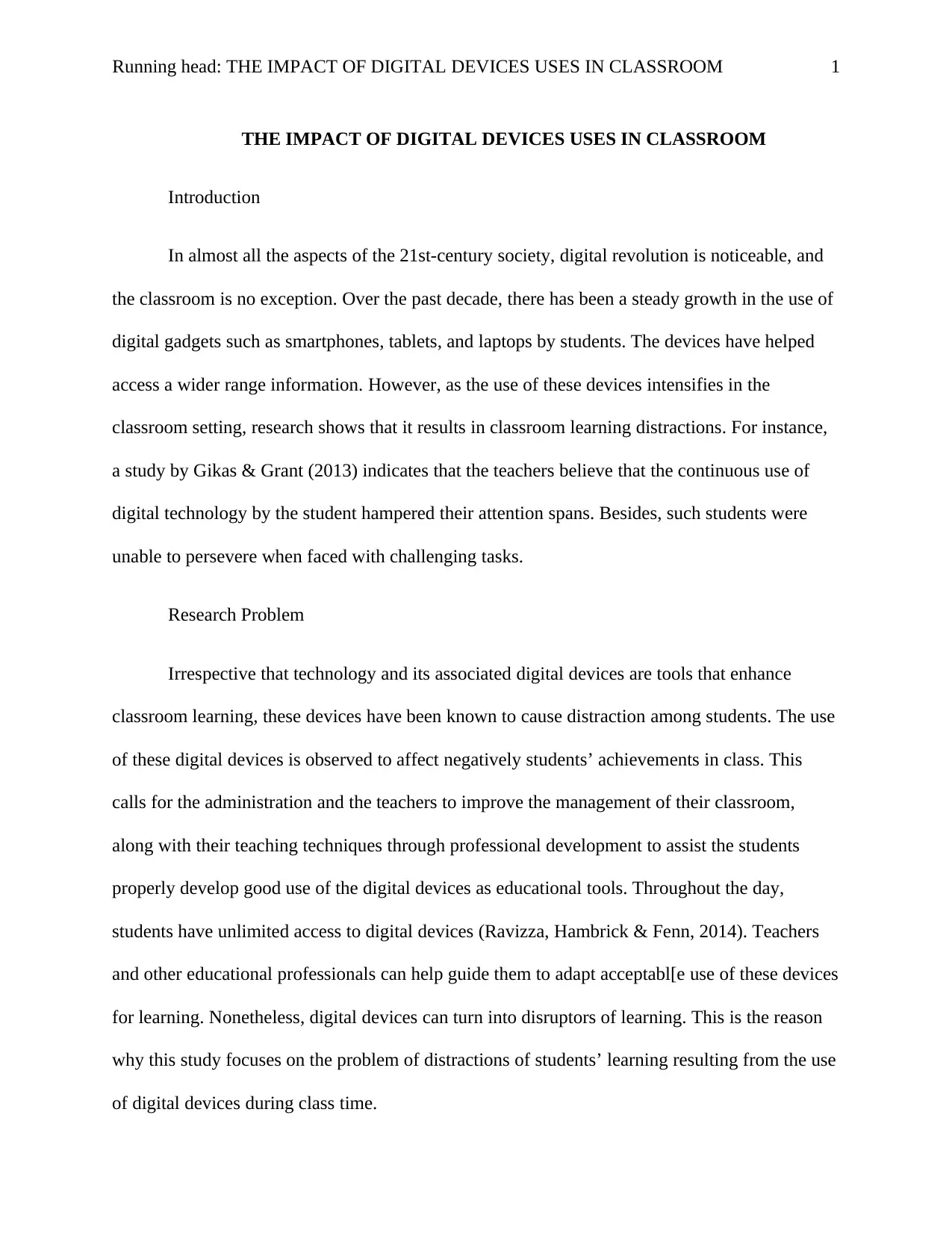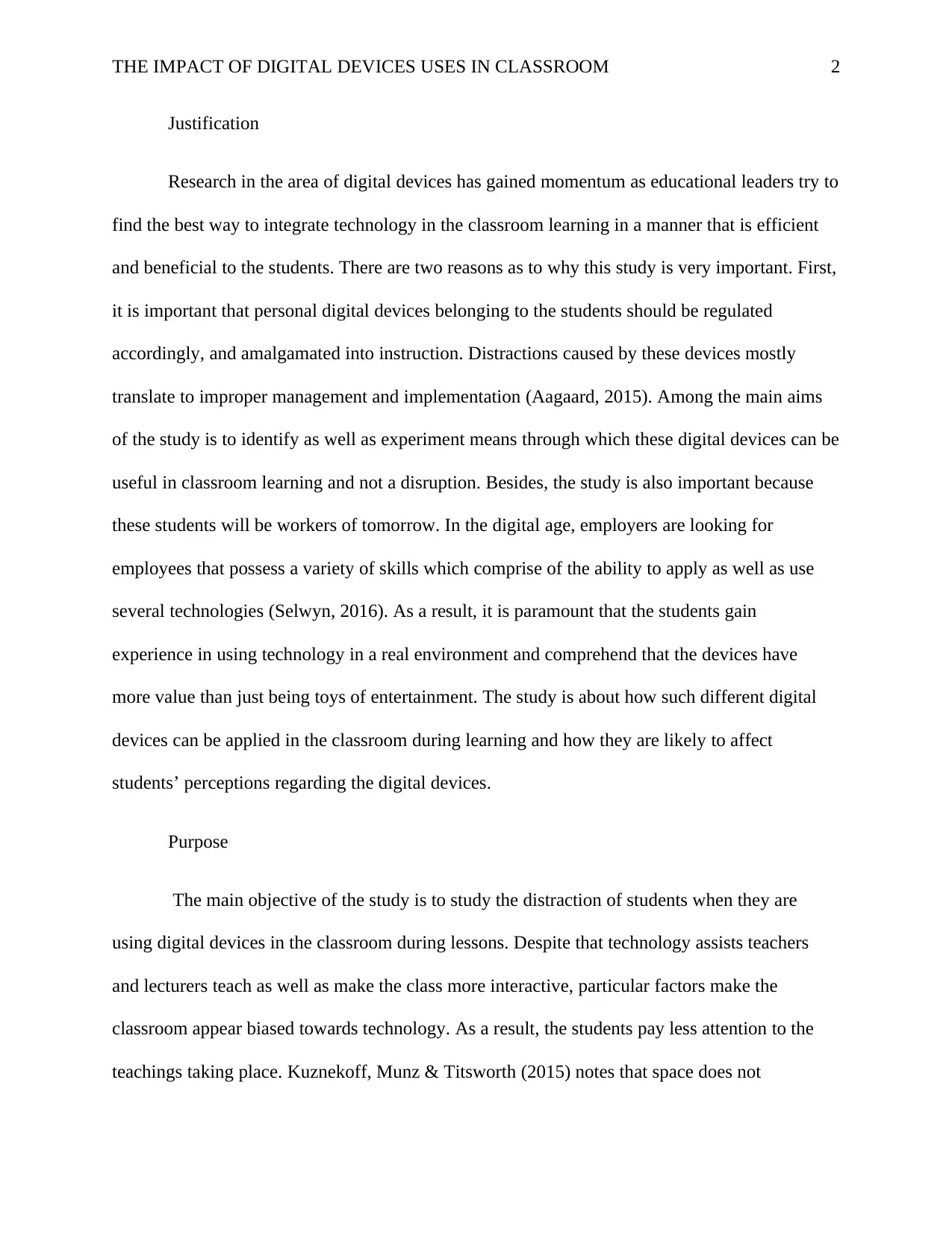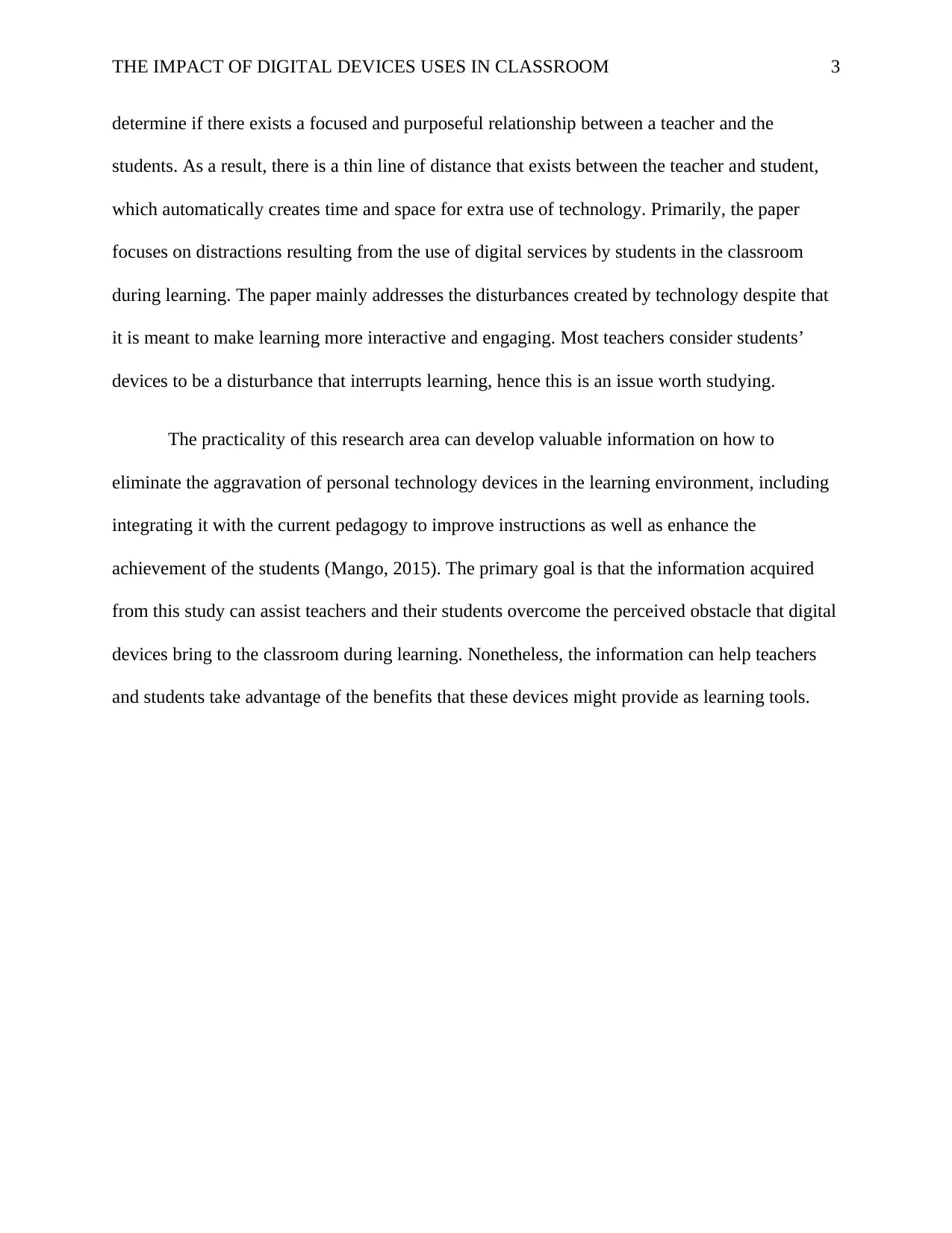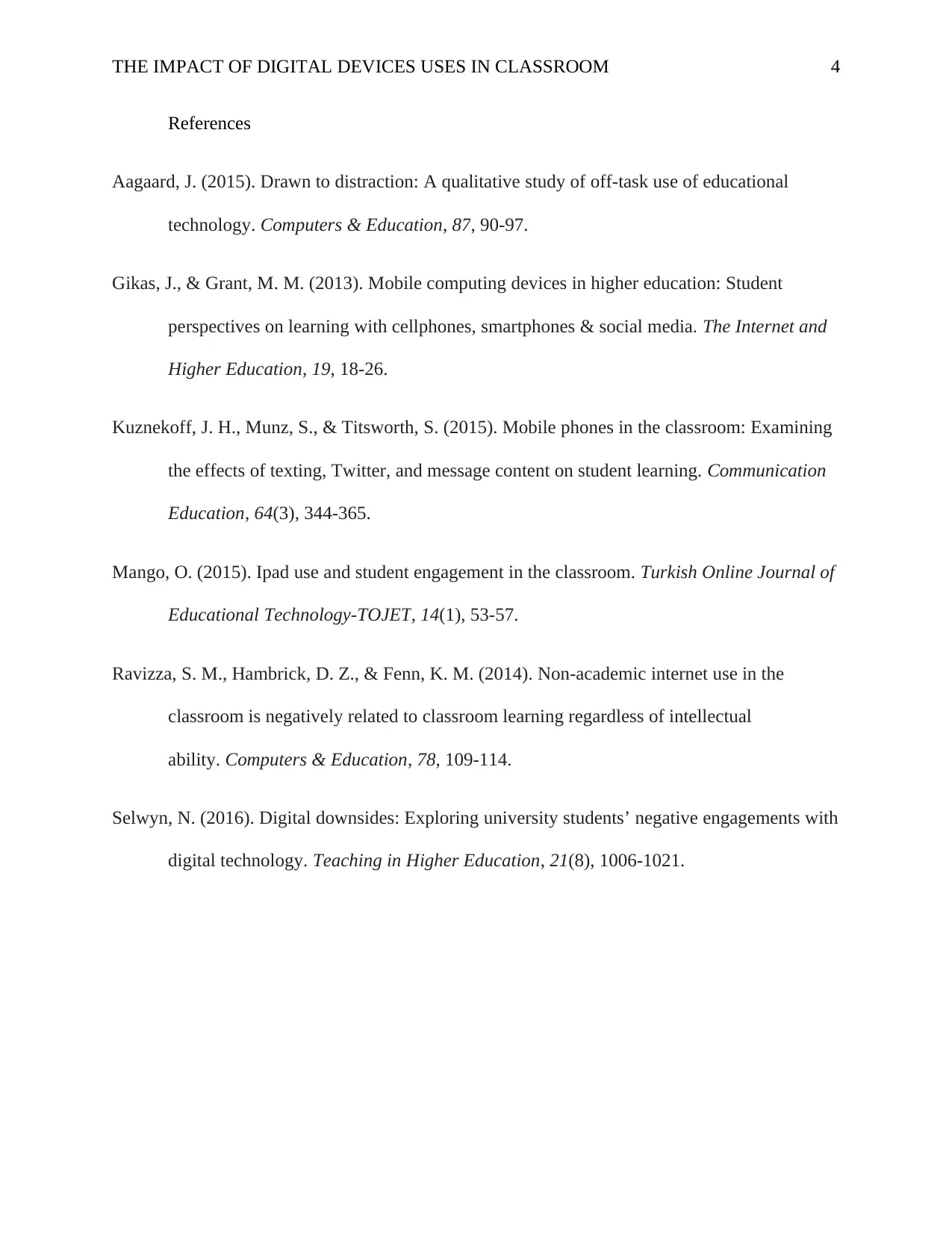Research Proposal: Digital Devices Use in Classroom Learning
VerifiedAdded on 2022/10/17
|4
|1093
|18
Homework Assignment
AI Summary
This assignment presents the preliminary components of a research proposal focusing on the impact of digital devices on student learning in the classroom. The introduction frames the research interest within the context of the digital revolution, highlighting the increasing use of smartphones, tablets, and laptops by students. The research problem centers on the distractions caused by these devices, which negatively affect student achievement. The justification emphasizes the importance of regulating personal digital devices and integrating them into instruction. The purpose of the study is to investigate student distraction when using digital devices during lessons, aiming to understand how to mitigate the negative impacts and leverage the benefits of technology to improve instruction and student achievement. The assignment includes an introduction, research problem, justification, and research purposes, supported by relevant citations.

Running head: THE IMPACT OF DIGITAL DEVICES USES IN CLASSROOM 1
THE IMPACT OF DIGITAL DEVICES USES IN CLASSROOM
Introduction
In almost all the aspects of the 21st-century society, digital revolution is noticeable, and
the classroom is no exception. Over the past decade, there has been a steady growth in the use of
digital gadgets such as smartphones, tablets, and laptops by students. The devices have helped
access a wider range information. However, as the use of these devices intensifies in the
classroom setting, research shows that it results in classroom learning distractions. For instance,
a study by Gikas & Grant (2013) indicates that the teachers believe that the continuous use of
digital technology by the student hampered their attention spans. Besides, such students were
unable to persevere when faced with challenging tasks.
Research Problem
Irrespective that technology and its associated digital devices are tools that enhance
classroom learning, these devices have been known to cause distraction among students. The use
of these digital devices is observed to affect negatively students’ achievements in class. This
calls for the administration and the teachers to improve the management of their classroom,
along with their teaching techniques through professional development to assist the students
properly develop good use of the digital devices as educational tools. Throughout the day,
students have unlimited access to digital devices (Ravizza, Hambrick & Fenn, 2014). Teachers
and other educational professionals can help guide them to adapt acceptabl[e use of these devices
for learning. Nonetheless, digital devices can turn into disruptors of learning. This is the reason
why this study focuses on the problem of distractions of students’ learning resulting from the use
of digital devices during class time.
THE IMPACT OF DIGITAL DEVICES USES IN CLASSROOM
Introduction
In almost all the aspects of the 21st-century society, digital revolution is noticeable, and
the classroom is no exception. Over the past decade, there has been a steady growth in the use of
digital gadgets such as smartphones, tablets, and laptops by students. The devices have helped
access a wider range information. However, as the use of these devices intensifies in the
classroom setting, research shows that it results in classroom learning distractions. For instance,
a study by Gikas & Grant (2013) indicates that the teachers believe that the continuous use of
digital technology by the student hampered their attention spans. Besides, such students were
unable to persevere when faced with challenging tasks.
Research Problem
Irrespective that technology and its associated digital devices are tools that enhance
classroom learning, these devices have been known to cause distraction among students. The use
of these digital devices is observed to affect negatively students’ achievements in class. This
calls for the administration and the teachers to improve the management of their classroom,
along with their teaching techniques through professional development to assist the students
properly develop good use of the digital devices as educational tools. Throughout the day,
students have unlimited access to digital devices (Ravizza, Hambrick & Fenn, 2014). Teachers
and other educational professionals can help guide them to adapt acceptabl[e use of these devices
for learning. Nonetheless, digital devices can turn into disruptors of learning. This is the reason
why this study focuses on the problem of distractions of students’ learning resulting from the use
of digital devices during class time.
Paraphrase This Document
Need a fresh take? Get an instant paraphrase of this document with our AI Paraphraser

THE IMPACT OF DIGITAL DEVICES USES IN CLASSROOM 2
Justification
Research in the area of digital devices has gained momentum as educational leaders try to
find the best way to integrate technology in the classroom learning in a manner that is efficient
and beneficial to the students. There are two reasons as to why this study is very important. First,
it is important that personal digital devices belonging to the students should be regulated
accordingly, and amalgamated into instruction. Distractions caused by these devices mostly
translate to improper management and implementation (Aagaard, 2015). Among the main aims
of the study is to identify as well as experiment means through which these digital devices can be
useful in classroom learning and not a disruption. Besides, the study is also important because
these students will be workers of tomorrow. In the digital age, employers are looking for
employees that possess a variety of skills which comprise of the ability to apply as well as use
several technologies (Selwyn, 2016). As a result, it is paramount that the students gain
experience in using technology in a real environment and comprehend that the devices have
more value than just being toys of entertainment. The study is about how such different digital
devices can be applied in the classroom during learning and how they are likely to affect
students’ perceptions regarding the digital devices.
Purpose
The main objective of the study is to study the distraction of students when they are
using digital devices in the classroom during lessons. Despite that technology assists teachers
and lecturers teach as well as make the class more interactive, particular factors make the
classroom appear biased towards technology. As a result, the students pay less attention to the
teachings taking place. Kuznekoff, Munz & Titsworth (2015) notes that space does not
Justification
Research in the area of digital devices has gained momentum as educational leaders try to
find the best way to integrate technology in the classroom learning in a manner that is efficient
and beneficial to the students. There are two reasons as to why this study is very important. First,
it is important that personal digital devices belonging to the students should be regulated
accordingly, and amalgamated into instruction. Distractions caused by these devices mostly
translate to improper management and implementation (Aagaard, 2015). Among the main aims
of the study is to identify as well as experiment means through which these digital devices can be
useful in classroom learning and not a disruption. Besides, the study is also important because
these students will be workers of tomorrow. In the digital age, employers are looking for
employees that possess a variety of skills which comprise of the ability to apply as well as use
several technologies (Selwyn, 2016). As a result, it is paramount that the students gain
experience in using technology in a real environment and comprehend that the devices have
more value than just being toys of entertainment. The study is about how such different digital
devices can be applied in the classroom during learning and how they are likely to affect
students’ perceptions regarding the digital devices.
Purpose
The main objective of the study is to study the distraction of students when they are
using digital devices in the classroom during lessons. Despite that technology assists teachers
and lecturers teach as well as make the class more interactive, particular factors make the
classroom appear biased towards technology. As a result, the students pay less attention to the
teachings taking place. Kuznekoff, Munz & Titsworth (2015) notes that space does not

THE IMPACT OF DIGITAL DEVICES USES IN CLASSROOM 3
determine if there exists a focused and purposeful relationship between a teacher and the
students. As a result, there is a thin line of distance that exists between the teacher and student,
which automatically creates time and space for extra use of technology. Primarily, the paper
focuses on distractions resulting from the use of digital services by students in the classroom
during learning. The paper mainly addresses the disturbances created by technology despite that
it is meant to make learning more interactive and engaging. Most teachers consider students’
devices to be a disturbance that interrupts learning, hence this is an issue worth studying.
The practicality of this research area can develop valuable information on how to
eliminate the aggravation of personal technology devices in the learning environment, including
integrating it with the current pedagogy to improve instructions as well as enhance the
achievement of the students (Mango, 2015). The primary goal is that the information acquired
from this study can assist teachers and their students overcome the perceived obstacle that digital
devices bring to the classroom during learning. Nonetheless, the information can help teachers
and students take advantage of the benefits that these devices might provide as learning tools.
determine if there exists a focused and purposeful relationship between a teacher and the
students. As a result, there is a thin line of distance that exists between the teacher and student,
which automatically creates time and space for extra use of technology. Primarily, the paper
focuses on distractions resulting from the use of digital services by students in the classroom
during learning. The paper mainly addresses the disturbances created by technology despite that
it is meant to make learning more interactive and engaging. Most teachers consider students’
devices to be a disturbance that interrupts learning, hence this is an issue worth studying.
The practicality of this research area can develop valuable information on how to
eliminate the aggravation of personal technology devices in the learning environment, including
integrating it with the current pedagogy to improve instructions as well as enhance the
achievement of the students (Mango, 2015). The primary goal is that the information acquired
from this study can assist teachers and their students overcome the perceived obstacle that digital
devices bring to the classroom during learning. Nonetheless, the information can help teachers
and students take advantage of the benefits that these devices might provide as learning tools.
⊘ This is a preview!⊘
Do you want full access?
Subscribe today to unlock all pages.

Trusted by 1+ million students worldwide

THE IMPACT OF DIGITAL DEVICES USES IN CLASSROOM 4
References
Aagaard, J. (2015). Drawn to distraction: A qualitative study of off-task use of educational
technology. Computers & Education, 87, 90-97.
Gikas, J., & Grant, M. M. (2013). Mobile computing devices in higher education: Student
perspectives on learning with cellphones, smartphones & social media. The Internet and
Higher Education, 19, 18-26.
Kuznekoff, J. H., Munz, S., & Titsworth, S. (2015). Mobile phones in the classroom: Examining
the effects of texting, Twitter, and message content on student learning. Communication
Education, 64(3), 344-365.
Mango, O. (2015). Ipad use and student engagement in the classroom. Turkish Online Journal of
Educational Technology-TOJET, 14(1), 53-57.
Ravizza, S. M., Hambrick, D. Z., & Fenn, K. M. (2014). Non-academic internet use in the
classroom is negatively related to classroom learning regardless of intellectual
ability. Computers & Education, 78, 109-114.
Selwyn, N. (2016). Digital downsides: Exploring university students’ negative engagements with
digital technology. Teaching in Higher Education, 21(8), 1006-1021.
References
Aagaard, J. (2015). Drawn to distraction: A qualitative study of off-task use of educational
technology. Computers & Education, 87, 90-97.
Gikas, J., & Grant, M. M. (2013). Mobile computing devices in higher education: Student
perspectives on learning with cellphones, smartphones & social media. The Internet and
Higher Education, 19, 18-26.
Kuznekoff, J. H., Munz, S., & Titsworth, S. (2015). Mobile phones in the classroom: Examining
the effects of texting, Twitter, and message content on student learning. Communication
Education, 64(3), 344-365.
Mango, O. (2015). Ipad use and student engagement in the classroom. Turkish Online Journal of
Educational Technology-TOJET, 14(1), 53-57.
Ravizza, S. M., Hambrick, D. Z., & Fenn, K. M. (2014). Non-academic internet use in the
classroom is negatively related to classroom learning regardless of intellectual
ability. Computers & Education, 78, 109-114.
Selwyn, N. (2016). Digital downsides: Exploring university students’ negative engagements with
digital technology. Teaching in Higher Education, 21(8), 1006-1021.
1 out of 4
Related Documents
Your All-in-One AI-Powered Toolkit for Academic Success.
+13062052269
info@desklib.com
Available 24*7 on WhatsApp / Email
![[object Object]](/_next/static/media/star-bottom.7253800d.svg)
Unlock your academic potential
Copyright © 2020–2025 A2Z Services. All Rights Reserved. Developed and managed by ZUCOL.





